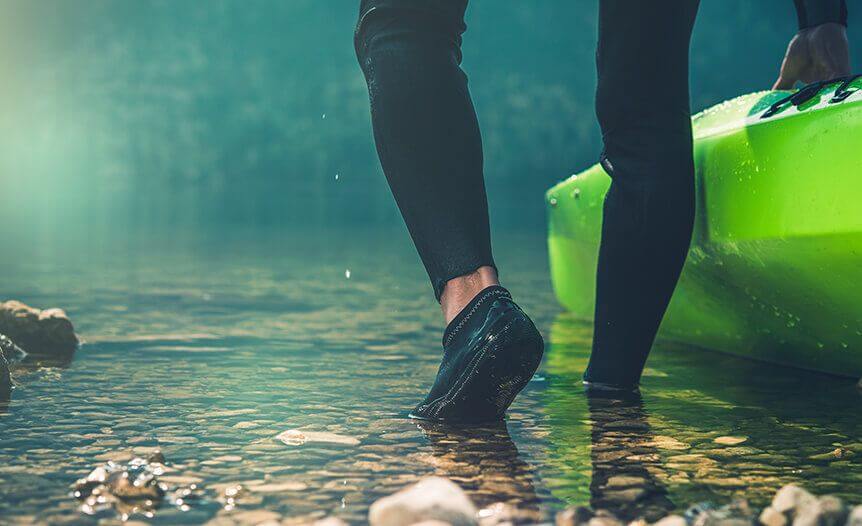How to use a Kayak Anchor?

How to use a Kayak Anchor?
Using an anchor in your fishing kayak is an excellent way to fish if you target certain fish species. In addition to keeping your kayak still and allowing you to focus on fishing, the anchor can also mean making sure your kayak is facing the correct way during tides. It can be easy to think that all you need to do is throw the anchor overboard; however, there is a little more to it than that. This article will cover some of the principles of anchoring your fishing kayak and offer advice to do it in the safest manner.
How to anchor a fishing kayak
Kayaks are well known for being stable, but when you anchor a kayak, it can add a tipping point if not done correctly. In most situations, anchoring from the bow or stern is the best method. Using a kayak anchor trolley is the easiest way to get your anchor to the correct position.
You may find there are times when fishing that you do not necessarily need to deploy an anchor, such as on a still lake. However, when fishing estuaries with tides and currents, an anchor can help keep you in place. In areas of a strong current, you need to know how to anchor correctly to avoid potential problems, such as capsizing.
When you use a kayak anchor trolley system, it allows you to choose if you set your anchor at the bow or stern, provided you have one running the entire length of your kayak. If you want to face the same direction as the tide, you can release the anchor from the stern, and if you want to face away, use the bow for your anchor.
Types of anchors for kayaks
There are two main types of anchors used for kayak anchoring. The anchor pole is often best used in shallow water, and the folding anchor (or grapnel anchor) is best used in deeper water. Both of these anchors are suitable for holding a kayak in position, and many experienced kayakers will own both types and take the one best suited to the type of kayaking they are doing.
Folding Grapnel Anchor
A folding grapnel anchor has four flukes that open when used and then close when it is on board. Kayak anchors range from 0.5-3kg. The size of the anchor is determined by how much weight they need to hold. For most kayaks, an anchor of 1.5kg is enough.
Folding anchors rely on a long rope and are dragged along the surface to take hold. When these are dragged, the flukes will embed themselves into the ground and take hold. Folding anchors are versatile and can be used in various vessels, including jet skis, stand-up paddleboards, and small boats. These are very popular and an excellent choice for most kayakers.
Anchor Pole
An anchor pole is a lightweight anchor best used in shallow water. These anchors are commonly 8ft (245cm) in length, although you can get extension poles to take them to 12ft (365cm). You can deploy an anchor pole through the scupper holes or by attaching it to a rope and clipped to your anchor trolley kit or any secure point on your kayak.
Anchor poles are ideal for kayak fishing when you are fishing close to the bank, and you don't want to drift downstream with the current.
Choosing the right kayak anchor line
The line you use for your kayak anchor is essential for your overall anchoring system. The rope needs to be thin enough to accommodate a light anchor and strong enough to hold your kayak in place. You'll find that a rope 5mm (or 3/16in) is a common choice for most kayak anglers.
What style of rope is best for a kayak anchor?
If you buy an anchor kit, it is attached with a suitable rope. However, if this gets damaged, you can use a length of polyester clothesline as a short-term replacement. One of the benefits of using polyester is that it is water-resistant, meaning it won't soak in water, and it'll dry quickly. The round line offers less water resistance, and when you pull it up, it won't dig into your hands.
How long does a kayak anchor line need to be?
An easy method to work out your anchor line length is to double the water depth. For example, if you're sitting in 5m of water, you should have at least 10m of anchor line. This length of anchor line will provide enough for your anchor to set correctly, and it won't put additional strain on the line in case of strong currents.
Using a kayak anchor trolley
A kayak anchor trolley is required to secure your kayak properly when fishing or at other times when you need your kayak to remain in position in the water. The anchor trolley was an invention that came about when kayaks were used in fishing, as anglers needed a good and safe way to keep their kayaks from drifting with the current. The anchor trolley usually consists of a thin paracord that connects to your kayak at two points. These points are either stern to midship or bow to midship. From then, a carabineer is clipped to close the loop, and the anchor rope is connected to it.
The anchor trolley provides a point where the kayaker can easily set the anchor to the bow or stern of their kayak. Using the trolley, you can send the kayak anchor to the front or rear of your kayak and retrieve it all from your cockpit. If the conditions change, you can alter the anchor point to benefit your position. Most kayak anchor trolley kits will give you enough equipment for one side of your kayak. Many professional anglers will rig up both sides to give them additional options.
There are many benefits to operating your kayak with an anchor trolley, but here are some of the best reasons:
- Flexibility during certain conditions - as the anchor point is adjustable, you can alter the position of your anchor to best suit the conditions you're experiencing.
- Improved stability - keeping your kayak positioned correctly means you lower the risk of tipping due to crosswinds.
- Eliminating additional anchor cleats - without an anchor trolley, you'd need to install extra anchor cleats for the same level of adjustable anchoring.
- Compatibility - an anchor trolley will work with most kayak anchors brands, which provide flexibility if you already own an anchor.
FAQ for kayak anchors
Types of anchors for your kayak
Can you use an anchor on a kayak?
Yes, using an anchor on a kayak is highly recommended. Many times, you may want to remain still on a kayak, such as when you are fishing or if you'd like to take some photos.
Do kayak anchors work?
A kayak anchor is ideal for maintaining your desired position in the water. These lightweight anchors offer good stopping power for any kayak angler.
How heavy of an anchor do you need for a kayak?
The weight of your kayak anchor will depend on its efficiency. With a folding anchor, you'll only need an anchor of about 1.5kg to maintain your anchored position. With other styles (mushroom, homemade, etc.), you may need up to 3kg.
How do you make a homemade anchor?
If you're into DIY projects, you can make a kayak anchor with an eyelet bolt, conduit pipe, nuts, a washer, and some cement. You'll need the anchor to weigh at least 3kg to hold your kayak safely. Make a frame, insert the bolt into the conduit, do up the nut, and pour in your cement. Allow the anchor to dry for a few days, then attach a rope, and you're good to go. Test the anchor in mild conditions before trusting it in more challenging situations.
What anchor should I get for my kayak?
The type of anchor you get depends on where you like to kayak. An anchor pole is ideal if you tend to stick to shallow water (less than 3m). For deeper waters, you should use a folding anchor.
Using a kayak anchor
What does a kayak anchor trolley do?
A kayak anchor trolley system will allow you to easily set the anchor from either the bow or stern from the comfort of the cockpit. You can place the anchor in the water and then use the trolley to move the anchor quickly to the bow or stern, depending on which is best for your situation.
How do you anchor a kayak without a trolley?
It is possible to set an anchor in a kayak without a trolley, but you'll need to install additional cleats to make sure you can easily set and retrieve your anchor. If you kayak in relatively still water, you can attach your anchor midship, but better practices are to attach it to either your bow or stern.
How do you attach an anchor to a kayak?
A kayak trolley kit is the best method for attaching an anchor to your kayak. However, if you do not have one of those, you can install a cleat specifically for the job or use an existing anchor point and clip your anchor rope to it.
How do you put an anchor trolley on a kayak?
An anchor trolley kit will come with enough equipment (tapping screws, etc.) and the appropriate installation instructions. If you follow the instructions, your kit will be installed safely and ready for use immediately. It is recommended you test out your system in mild conditions before relying on it in more challenging areas.
How does an anchor pole work?
An anchor pole is directly placed into the river bed. The pole can be deployed using scupper holes or attached to a rope and secured to the bow in a kayak. Anchor poles are handy when kayak fishing due to their silent deployment.
Is an anchor trolley necessary?
An anchor trolley offers flexibility and convenience. The trolley system allows you to choose where your anchor is attached, making retrieval easier. When using a grapnel anchor, you'll find that having a trolley line provides additional security in challenging conditions.
Should you anchor a kayak?
You may find that during calm conditions, or if you are into scenic kayaking, an anchor may not be high on your priority. However, when kayak fishing, you often need to keep your kayak still, and in these situations.
Where do you put the anchor on a kayak?
When the anchor is not used, it can be stowed inside a hatch or placed under your kayak seat. You can also secure the anchor with a bungee cord or velcro straps. As long as the anchor is adequately secured so it won't fall overboard when not needed, it will be good wherever you place it.
Where to buy the best kayak anchor
At Kayaks2Fish, we have an excellent selection of anchor kits, trolley kits, and all other necessary items to secure your kayak correctly. You can shop in our online store, and our items are available for collection from your chosen location, or they can be shipped directly to your address.
If you need any additional information about kayaking and anchors, you can call our team, and we'll be happy to help you out. Our staff are all fully trained, and after asking you a few questions, we'll suggest the perfect kayak anchor system for you.










